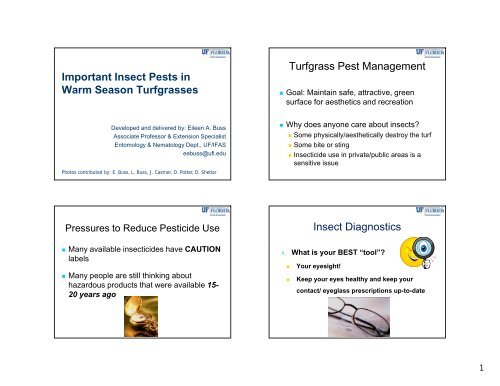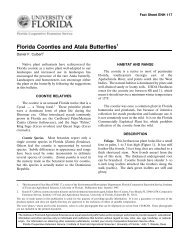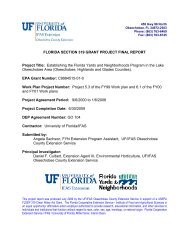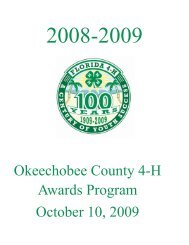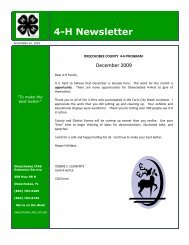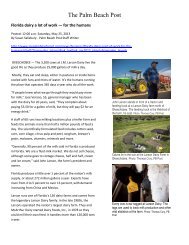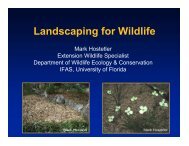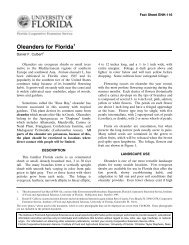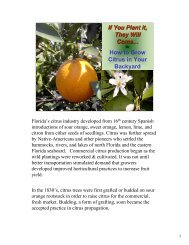Important Insect Pests in Warm Season Turfgrasses Turfgrass Pest ...
Important Insect Pests in Warm Season Turfgrasses Turfgrass Pest ...
Important Insect Pests in Warm Season Turfgrasses Turfgrass Pest ...
You also want an ePaper? Increase the reach of your titles
YUMPU automatically turns print PDFs into web optimized ePapers that Google loves.
<strong>Important</strong> <strong>Insect</strong> <strong><strong>Pest</strong>s</strong> <strong>in</strong><br />
<strong>Warm</strong> <strong>Season</strong> <strong><strong>Turfgrass</strong>es</strong><br />
<strong>Turfgrass</strong> <strong>Pest</strong> Management<br />
• Goal: Ma<strong>in</strong>ta<strong>in</strong> safe, attractive, green<br />
surface for aesthetics and recreation<br />
Developed and delivered by: Eileen A. Buss<br />
Associate Professor & Extension Specialist<br />
Entomology & Nematology Dept., UF/IFAS<br />
eabuss@ufl.edu<br />
Photos contributed by: E. Buss, L. Buss, J. Castner, D. Potter, D. Shetlar<br />
• Why does anyone care about <strong>in</strong>sects?<br />
• Some physically/aesthetically destroy the turf<br />
• Some bite or st<strong>in</strong>g<br />
• <strong>Insect</strong>icide use <strong>in</strong> private/public areas is a<br />
sensitive issue<br />
Pressures to Reduce <strong>Pest</strong>icide Use<br />
• Many available <strong>in</strong>secticides have CAUTION<br />
labels<br />
• Many people are still th<strong>in</strong>k<strong>in</strong>g about<br />
hazardous products that were available 15-<br />
20 years ago<br />
<strong>Insect</strong> Diagnostics<br />
1. What is your BEST “tool”?<br />
• Your eyesight!<br />
• Keep your eyes healthy and keep your<br />
contact/ eyeglass prescriptions up-to-date<br />
1
Monitor<strong>in</strong>g<br />
Soap flush<br />
Visual sampl<strong>in</strong>g<br />
Vacuum sample<br />
• Use about 2 TBSP per gallon of water, and use 2 gallons<br />
of mix per square yard of turf<br />
• Test this solution <strong>in</strong> an <strong>in</strong>conspicuous area to see if turf<br />
damage occurs<br />
•Joy, Dawn Ultra & Ivory Clear rarely cause phytotoxicity<br />
Flotation or turf<br />
sample<br />
<strong>Important</strong> Th<strong>in</strong>gs to Look For<br />
Describe the symptoms…<br />
• Mouthparts (chew<strong>in</strong>g vs. suck<strong>in</strong>g)<br />
• Body shape (long vs. th<strong>in</strong>, broad vs.<br />
narrow)<br />
• W<strong>in</strong>gs (Present or absent? Texture –<br />
leathery, membranous, hard? Equal length?<br />
Lots of ve<strong>in</strong>s or very few?)<br />
• Antennae – beadlike, elbowed, etc.<br />
• Legs – jump<strong>in</strong>g, walk<strong>in</strong>g, digg<strong>in</strong>g, swimm<strong>in</strong>g,<br />
…<br />
2
Look for silken webb<strong>in</strong>g<br />
Tropical sod webworm ID<br />
Larva and frass <strong>in</strong> St. August<strong>in</strong>egrass<br />
Adults lack the elongate<br />
palps of regular sod<br />
webworms, and they hold<br />
the w<strong>in</strong>gs flat, <strong>in</strong> a<br />
triangular shape<br />
What do you need to know to<br />
manage caterpillars?<br />
Describe the symptoms…<br />
• Infestations beg<strong>in</strong> <strong>in</strong> the spr<strong>in</strong>g, but damag<strong>in</strong>g<br />
g<br />
populations build <strong>in</strong> late summer and fall (pops.<br />
are year-round <strong>in</strong> S. FL)<br />
• Larvae develop better on fertilized turf<br />
• Kill<strong>in</strong>g young larvae is easier than for old larvae;<br />
don’t target eggs, pupae & adults<br />
• Products like Dipel (Bt), Conserve, & Dimil<strong>in</strong> are<br />
most effective aga<strong>in</strong>st young larvae<br />
• Rotate <strong>in</strong>secticide modes of action (Acelepryn)<br />
3
Where do ch<strong>in</strong>ch bugs<br />
live and feed?<br />
<strong>Pest</strong> identification<br />
Small eyes<br />
W<strong>in</strong>g pads<br />
Reddish-orange body<br />
with white stripe<br />
Black triangle<br />
on white w<strong>in</strong>gs<br />
Adult and fifth <strong>in</strong>star<br />
Young nymphs<br />
False Ch<strong>in</strong>ch Bug Damage – Close up<br />
False Ch<strong>in</strong>ch Bug Damage, St. Petersburg, FL<br />
4
False Ch<strong>in</strong>ch Bug (Nysius raphanus)<br />
◦ Sporadic pest, usually not damag<strong>in</strong>g<br />
◦ Same body shape as SCB, but different colors<br />
◦ Prefers plants <strong>in</strong> the mustard family (canola,<br />
radish), potato, lettuce, pigweed, turfgrasses<br />
◦ Mass migrations occur <strong>in</strong> hot, dry weather<br />
◦ Control: Pyrethroids<br />
What do you need to know to<br />
manage ch<strong>in</strong>ch bugs?<br />
• 1 generation (egg to adult) takes 4-6 wks, and<br />
adults can live up to 2 months<br />
• <strong>Insect</strong>icides kill nymphs and adults, but not the<br />
eggs<br />
• Apply<strong>in</strong>g more nitrogen = more eggs be<strong>in</strong>g laid<br />
• Thick thatch is a great habitat and the organic<br />
matter b<strong>in</strong>ds certa<strong>in</strong> <strong>in</strong>secticides (e.g., pyrethroids)<br />
• <strong>Insect</strong>icide resistance is real: ROTATE!!!<br />
Rhodesgrass Mealybug<br />
Rhodesgrass Mealybug<br />
(Anton<strong>in</strong>a gram<strong>in</strong>is)<br />
• Infested grass looks “tufted” – has shortened<br />
<strong>in</strong>ternodes, similar to mite damage<br />
• At least 1 mealybug is near the sprig base<br />
• Also a sporadic pest of turfgrasses;<br />
damage is worse <strong>in</strong> hot, dry weather<br />
• Feed <strong>in</strong> leaf sheaths, nodes, or at the crown<br />
• Only females; each 1 lays 300-600 eggs<br />
• 1 generation <strong>in</strong> 4-6 wks<br />
• Control?<br />
5
Describe the symptoms<br />
How can you confirm that grubs are<br />
the problem?<br />
Where do grubs live and feed?<br />
Some scarabs make mounds<br />
Pocket gopher<br />
Peltotrupes profundus<br />
Green June beetle cast<strong>in</strong>g<br />
6
<strong>Pest</strong> identification<br />
Identification of common grubs<br />
• Scarabs vary <strong>in</strong> size, color, and habits, but<br />
adults have 3-segmented, clubbed antennae<br />
• Larvae molt 3 times (have 3 <strong>in</strong>stars)<br />
• Look at raster (hair) pattern for grub ID<br />
Raster<br />
Antenna<br />
Sugarcane<br />
grub<br />
EGG<br />
LARVA<br />
PUPA<br />
ADULT<br />
What do you need to know to<br />
manage grubs?<br />
Follow<strong>in</strong>g rescue treatments (Sev<strong>in</strong> or Dylox), GJB and<br />
flower beetle grubs often come to surface to die!<br />
• Development time depends on species;<br />
generally 1-2 generations per year <strong>in</strong> Florida<br />
• <strong>Insect</strong>icides should be targeted aga<strong>in</strong>st newly<br />
hatched first <strong>in</strong>stars; curative control of 3 rd<br />
<strong>in</strong>stars is harder to achieve<br />
• Some grubs like areas of high organic matter;<br />
avoid organic fertilizers (e.g., chicken litter)<br />
• <strong>Insect</strong>icides usually need to be watered <strong>in</strong> to<br />
reach the soil<br />
7
Describe the symptoms…<br />
Mole cricket subsurface tunnel<strong>in</strong>g<br />
uproots plants, result<strong>in</strong>g <strong>in</strong> the<br />
roots dry<strong>in</strong>g out. Tawny and<br />
shortw<strong>in</strong>ged mole crickets also<br />
feed on the roots, result<strong>in</strong>g <strong>in</strong> turf<br />
<strong>in</strong>jury. Large nymphs make small<br />
mounds <strong>in</strong> late summer when<br />
they emerge to feed on the soil<br />
surface at night.<br />
Mole cricket identification<br />
Pronotum<br />
Dactyls (digg<strong>in</strong>g claws)<br />
Tawny MC Shortw<strong>in</strong>ged MC Southern MC<br />
What do you need to know to<br />
manage mole crickets?<br />
• Most eggs hatch from May to July<br />
gg y y<br />
• Nymphs and adults are nocturnal, so<br />
applications timed for early morn<strong>in</strong>g or late<br />
afternoon may be more successful<br />
• Young nymphs are easier to kill than old<br />
nymphs and adults<br />
• Baits are effective <strong>in</strong> late summer & fall<br />
• Some <strong>in</strong>secticides repel mole crickets<br />
8
Fire Ants<br />
• Health hazard: pa<strong>in</strong>ful st<strong>in</strong>gs, allergic reactions<br />
• Colonies <strong>in</strong>vade sunny, open, and disturbed areas,<br />
like playgrounds and athletic fields<br />
• Mounds can be a turf aesthetic problem<br />
• Colonies can nest <strong>in</strong> electrical boxes<br />
• Fire ants are predators of other pests<br />
eXtension:<br />
http://www.extension.org/pages/9730/imported-fire-ants-membership<br />
Fire Ant Baits – common ai’s<br />
• Abamect<strong>in</strong><br />
• Fenoxycarb<br />
• Fipronil<br />
• Hydramethylnon<br />
• Indoxacarb<br />
• (S)-methoprene<br />
• Pyriproxyfen<br />
• Sp<strong>in</strong>osad<br />
How Do You Know It Worked?<br />
• Ants and mounds disappear for a while<br />
• Mounds are not just rebuilt somewhere<br />
else<br />
• Reduction <strong>in</strong> st<strong>in</strong>gs<br />
• But, be warned…<br />
• Treated turf can be re<strong>in</strong>fested from<br />
neighbor<strong>in</strong>g, untreated areas<br />
9


